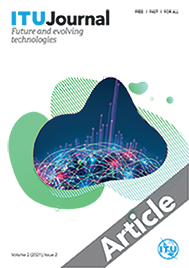|
EMR: A new metric to assess the resilience of directional mmWave channels to blockages
|
Authors: Fatih Erden, Ozgur Ozdemir, Ismail Guvenc, David W. Matolak
Status: Final
Date of publication: 20 September 2021
Published in: ITU Journal on Future and Evolving Technologies, Volume 2 (2021), Issue 2, Pages 47-60
Article DOI : https://doi.org/10.52953/HZOB9789
|
 | Abstract:
Millimeter-wave (mmWave) communication systems require narrow beams to compensate for high path loss and to increase the communication range. If an obstacle blocks the dominant communication direction, alternative paths (directions) should be quickly identified to maintain reliable connectivity. In this paper, we introduce a new metric to quantify the Effective Multipath Richness (EMR) of a directional communication channel in the angular domain. In particular, the proposed metric takes into account the strength and spatial diversity of the resolved Multipath Components (MPCs), while also considering the beamwidth of the communication link and the blockage characteristics. The metric is defined as a weighted sum of the number of distinct MPC clusters in the angular domain, where the clustering of the MPCs is performed based on the cosine-distance between the dominant MPCs.
For a given transmitter (TX) and receiver (RX) pair, the EMR is a single scalar value that characterizes the robustness of the communication link against blockages, as it captures the number of unique communication directions that can be utilized. It is also possible to characterize the blockage robustness for the whole environment by evaluating the spatial distribution of the EMR metric considering various different TX/RX locations. Using our proposed metric, one can assess the scattering richness of different environments to achieve a particular service quality. We evaluate the proposed metric using our 28 GHz channel measurements in a library environment for Line-of-Sight (LOS) and NLOS scenarios, and compare it with some other commonly used propagation metrics. We argue that EMR is especially informative at higher frequencies, e.g., mmWave and terahertz (THz), where the propagation attenuation is high, and directional Non-Light-of-Sight (NLOS) communication is critical for the success of the network. |
|
Keywords: 28 GHz, 5G, 6G, angular spread, blockage, delay spread, millimeter-wave (mmWave), multipath components (MPCs), multipath richness
Rights: © International Telecommunication Union, available under the CC BY-NC-ND 3.0 IGO license.
|
|
| ITEM DETAIL | ARTICLE | PRICE | |
|---|
ENGLISH  Full article (PDF)
Full article (PDF) |
|
| 0
| Free of charge | DOWNLOAD |
|
|
| |